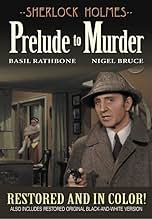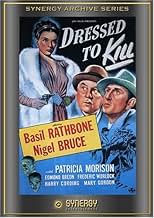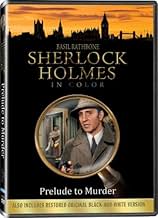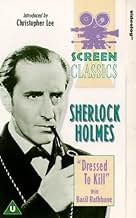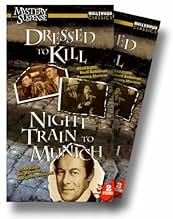AVALIAÇÃO DA IMDb
6,8/10
7,3 mil
SUA AVALIAÇÃO
Adicionar um enredo no seu idiomaA trio of music boxes contains the hidden secret to riches, and a group of criminals will kill for them. In Vibrant Color.A trio of music boxes contains the hidden secret to riches, and a group of criminals will kill for them. In Vibrant Color.A trio of music boxes contains the hidden secret to riches, and a group of criminals will kill for them. In Vibrant Color.
- Direção
- Roteiristas
- Artistas
Edmund Breon
- Julian 'Stinky' Emery
- (as Edmond Breon)
Frederick Worlock
- Col. Cavanaugh
- (as Frederic Worlock)
Harry Allen
- Scottish Man at Auction
- (não creditado)
Frank Baker
- Photographer
- (não creditado)
Guy Bellis
- Doctor
- (não creditado)
Wilson Benge
- Minister on Museum Tour
- (não creditado)
Marjorie Bennett
- Antique Shop Assistant
- (não creditado)
Ted Billings
- Pub Patron
- (não creditado)
- Direção
- Roteiristas
- Elenco e equipe completos
- Produção, bilheteria e muito mais no IMDbPro
Avaliações em destaque
The last in a wonderful cycle of 14 movies that got launched by a different major production company but always kept the brilliant duo of lead actors Basil Rathbone and Nigel Bruce as Sherlock Holmes and his loyal assistant Dr. Watson. Some say this is a much weaker entry in the series but, quite frankly, I have no idea on what arguments those opinions are based, as this is another marvelously scripted and professionally directed detective adventure! When an old school friend of Dr. Watson is found murdered, Sherlock Holmes immediately suspects that this has something to do with his latest collector's item purchase, namely a wooden musical box. Two other identical boxes were made by a convicted burglar in prison and the altered melody hides a secret code that leads his accomplices to the location of two stolen Bank of England printing plates! True, the valuable-objects-hidden-at-different-locations premise is somewhat similar to the previous Holmes film "The Pearl of Death" and may therefore come across as unoriginal, but the screenplay contains more than enough variety to make "The Secret Code" another very compelling mystery film. Holmes female opponent, for example, is a truly clever woman who nearly succeeds in setting a trap for our brilliant detective during a very well-mounted sequence. Furthermore, "The Secret Code" (I refuse to use the completely irrelevant title "Dressed to Kill") is fast-paced and contains loads of terrific dialogues. As usual, Bruce's character Dr. Watson provides the story with a couple of neat comical moments, most notably the scene in which he tries to comfort a little girl who just got traumatized by imitating the sound of a duck...impressively, I may add.
"Dressed to Kill" puts Sherlock Holmes and the devoted but bumbling Dr. Watson on the trail of a ruthless gang intent on securing - by hook, crook or thrown dagger - three seemingly innocuous music boxes. The boxes come from a workshop in one of England's famous prisons. Perhaps vocational rehabilitation of cons has its downside.
The conspirators - a suave gentleman-type, a thuggish chauffeur and a beautiful woman - come close to writing finis to Holmes's career and his life. Of course they can not succeed where Dr. Moriarty has failed.
Set in a London past the time of Conan Doyle, the film features a never to be overused "follow that cab" episode. The usually exclusively cerebral Holmes here actually does some strenuous exercise and proves handy with a revolver.
Fun to watch, this isn't the best Rathbone/Bruce Holmes film but it's pleasant enough for a late, cold winter night's entertainment.
7/10.
The conspirators - a suave gentleman-type, a thuggish chauffeur and a beautiful woman - come close to writing finis to Holmes's career and his life. Of course they can not succeed where Dr. Moriarty has failed.
Set in a London past the time of Conan Doyle, the film features a never to be overused "follow that cab" episode. The usually exclusively cerebral Holmes here actually does some strenuous exercise and proves handy with a revolver.
Fun to watch, this isn't the best Rathbone/Bruce Holmes film but it's pleasant enough for a late, cold winter night's entertainment.
7/10.
This is a solid Sherlock Holmes mystery in the Basil Rathbone/Nigel Bruce series, with an interesting story, a good villainess, and a good pace once it gets going. Although, as with many movies in the series, the plot is not found in any of the original Holmes books, a number of the story elements were drawn or adapted from various Doyle stories. A number of times Watson also makes reference to one of the 'canonical' cases.
The setup is good, and it produces some interesting possibilities. Holmes must not only figure out a peculiar puzzle involving music boxes, but must do so in a race with a criminal gang that is trying to accomplish the same thing. Patricia Morison makes an elegant adversary for Holmes, and Rathbone and Bruce work well together as always.
Although these later movies in the series do not hold closely to the Victorian atmosphere of the originals, most of them are pretty good in their own right, and while this one mostly follows the usual formula, it is an enjoyable entry in the series.
The setup is good, and it produces some interesting possibilities. Holmes must not only figure out a peculiar puzzle involving music boxes, but must do so in a race with a criminal gang that is trying to accomplish the same thing. Patricia Morison makes an elegant adversary for Holmes, and Rathbone and Bruce work well together as always.
Although these later movies in the series do not hold closely to the Victorian atmosphere of the originals, most of them are pretty good in their own right, and while this one mostly follows the usual formula, it is an enjoyable entry in the series.
A suspenseful Holmes and Watson feature about a group of killers out to find three music boxes sold at an auction. The boxes contain something in them that will help lead the crooks to loads of money. Only problem is that Sherlock Holmes is on their trail. Typical good acting and tight direction help this one rise above its somewhat implausible story. The chemistry between Rathbone and Bruce is as ever the binding of the film. Some other good performances are given by Patricia Morrison as a wicked woman and Edmund Breon as "Stinky," a school chum of Watson's. The verbal banter between Morrison and Holmes is for me the most memorable aspect of the film. As I watched the film, the lines slowly crept back into my head. "Praise from you is indeed gratifying Mr. Holmes," and then a line about respecting his memory. Great stuff!
The last Rathbone Holmes (14/14) is again a slightly weaker affair than most of the preceding entries, another variant of The Pearl of Death this time involving music boxes. Music boxes whose tunes play out the location of the stolen and hidden Bank of England £5 plates no less. Holmes proves he has an inbuilt police whistle and a photographic(?) memory for music, whilst Watson says that he likes brass bands but is tone deaf. The woman here, although a thoroughly bad hat is not The Woman, the one and only Irene Adler who had bested Holmes in 1891, but for most of the film she has the upper hand.
By now the steam had left Rathbone, and although Bruce wanted to carry on and Universal held the copyright until 1949 the series had reached its natural conclusion. Director Roy William Neill had less than a year left to live too. Some lovely bits: Holmes consoling Mrs Hudson, distraught at letting 2 people into 221b who turned it over; Holmes' biscuit jar was seen to good advantage. And yes, the bullet holes in the wall from Faces Death were still there at the end! No matter how bad, mawkish or daft this marvellous series got I've always loved every entry. Watching a clean Definitive DVD of this with a lump in my throat I think of Brian Wilson's line "It's so sad to watch a sweet thing die", without even the dignity of end credits (they're lost).
All things must pass.
By now the steam had left Rathbone, and although Bruce wanted to carry on and Universal held the copyright until 1949 the series had reached its natural conclusion. Director Roy William Neill had less than a year left to live too. Some lovely bits: Holmes consoling Mrs Hudson, distraught at letting 2 people into 221b who turned it over; Holmes' biscuit jar was seen to good advantage. And yes, the bullet holes in the wall from Faces Death were still there at the end! No matter how bad, mawkish or daft this marvellous series got I've always loved every entry. Watching a clean Definitive DVD of this with a lump in my throat I think of Brian Wilson's line "It's so sad to watch a sweet thing die", without even the dignity of end credits (they're lost).
All things must pass.
Você sabia?
- CuriosidadesThe last of 14 films released from 1939-46 based on Arthur Conan Doyle's fictional consulting detective Sherlock Holmes starring Basil Rathbone as Holmes and Nigel Bruce as Dr. Watson. Rathbone was reportedly tired of playing the character. However, he would play Holmes on the stage, radio and television at various times the rest of his career.
- Erros de gravaçãoDr. Watson is repeatedly described as having "no ear for music". Yet in two previous films of the series, he is seen both singing and playing the tuba.
- Citações
Colonel Cavanaugh: By now Mr. Holmes has no doubt exchanged his violin for a harp.
Mrs. Hilda Courtney: Oh, well, assuming that Heaven is his destination.
- Cenas durante ou pós-créditosThis movie's final credit sequence rolled over a scene of Basil Rathbone and Nigel Bruce leaving Dr. Johnston's house. This sequence was later removed by a TV distributor and has been replaced with a THE END frame from one of the earlier Sherlock Holmes films.
- Versões alternativasOriginally, this movie ended with the final credits superimposed over a shot of Holmes and Watson leaving Dr. Johnson's house. This footage was trimmed by TV distributors and is now lost, so the MPI restorers had to tack on a THE END sequence from another film to finish this Sherlock Holmes film.
- ConexõesFeatured in The Many Faces of Sherlock Holmes (1985)
- Trilhas sonorasThe Swagman
(uncredited)
Australian folk song
Played on a music box several times
Played on piano and on violin by Basil Rathbone and whistled by him
Played on piano by Wallace Scott
Principais escolhas
Faça login para avaliar e ver a lista de recomendações personalizadas
- How long is Dressed to Kill?Fornecido pela Alexa
Detalhes
- Data de lançamento
- País de origem
- Central de atendimento oficial
- Idioma
- Também conhecido como
- Vestida Para Matar
- Locações de filme
- Empresas de produção
- Consulte mais créditos da empresa na IMDbPro
Bilheteria
- Orçamento
- US$ 100.000 (estimativa)
- Tempo de duração
- 1 h 11 min(71 min)
- Cor
- Proporção
- 1.33 : 1
Contribua para esta página
Sugerir uma alteração ou adicionar conteúdo ausente


